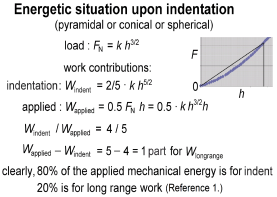
Gerd Kaupp
University of Oldenburg, Germany
Title: ISO-standards 14577 violate the first energy law: Can we further live with that?
Biography
Biography: Gerd Kaupp
Abstract
The precise mathematical deduction from 2013 of the indentation work contribution that is lost for the penetration reveals that all the standards under ISO-14577 violate the first energy law. This concerns the definition of ISO-hardness and reduced modulus and also deduced further mechanical parameters. And also the recently published physical foundation of the experimentally validated (since 2003 by the author) exponent 3/2 on the depth h for pyramidal indentations, creates dilemma for industry and security agencies, while ISO still dictates exponent two in relation to the applied normal force FN, as in Sneddon-citing textbooks. They have to obey ISO standards with legal character, even though physics tells differently. Even NIST (US member of ISO) published six new mechanical parameters in a tutorial that continues distributing false physics using exponent two and energy-law violation. We must thus urgently try to change that situation, because falsely calculated mechanical properties severely harm all public in daily life, in medicine (implants), and techniques. Material's compatibilities (including solders) and mechanical stress are ubiquitous, to name a few. Material's failures have been claimed as fatigue of materials, rather than calculations against physics and violating the energy-law. Errors are also with finite element simulations always resulting with exponent two, not noticing phase transitions with their onset and energy, nor surface effects. These are only recognized when applying exponent 3/2, but not by polynomial curve fittings, or best exponent iterations. Almost all mechanical parameters require re-deduction on the basis of the correct exponent. ISO-hardness H and ISO-modulus Er are triply flawed: Violating energy law, false exponent and often unconscious characterization after phase transitions. All materials require genuine and reliable physical characterization! Thus, physical H, Er and other parameters (adhesion energy, etc.) must be deduced. This will be addressed upon, and unexpected applications will be presented.

Recent Publications
- Kaupp G, (2013) Penetration resistance: a new approach to the energetics of indentations. Scanning 35: 392-401.
- Kaupp G (2013) Penetration Resistance and Penetrability in Pyramidal (Nano)Indentations. Scanning 35: 88-111
- Kaupp G (2014)Activation energy of the low-load NaCl transition from nanoindentation loading curves, Scanning 36: 582-589. Kaupp.G (2016).
- Kaupp G (2016) The physical foundation of FN = k h^3/2 for conical/pyramidal indentation loading curves. Scanning 38: 177-179; Open Access.
- Kaupp G (2006) Dilemma zwischen ISO und Physik: Nanotechnologie deckt auf. Nanobay, 3. May 2016.
- Kaupp G, Naimi-Jamal MR (2013) Penetration resistance and penetrability in pyramidal (nano)indentations, Scanning 35, 88-111.
- Kaupp G, Naimi-Jamal MR (2011) Universal penetration resistance and penetratability from pyramidal nanoindentations. Proceedings of the International Indentation Workshop 4 IIW4 in Seoul, Korea, on July 3rd – 8th, 2011
- Kaupp G, Naimi-Jamal MR (2010), The exponent 3/2 at pyramidal nanoindentations, SCANNING 32: 265-281.
- Naimi-Jamal MR, Kaupp G (2005) Quantitative evaluation of nanoindents: do we need more reliable mechanical parameters for the characterization of materials? Z. Metallkd. 96:1226-1236.
- Kaupp G, Schmeyers J, Hangen UD (2002) Anisotropic molecular movements in organic crystals by mechanical stress without chemical reaction. J.Phys.Org.Chem 15: 307-315.

